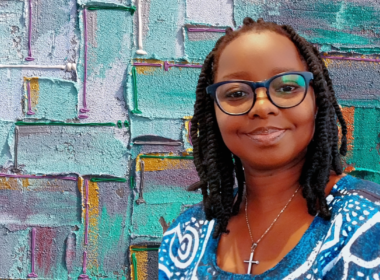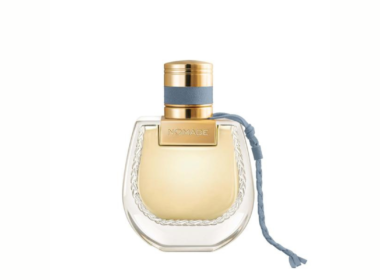Santa GAÏA Pilens, an artist, blends ancient techniques with modern storytelling. Her work speaks to the collective unconscious, channelling themes from folk art, mysticism, and history. Over the past decade, GAÏA has moved from chronicling the world through photography to incorporating complex narratives into her signature textile murals, a process she calls “contemporary mummies.” She deftly balances what is seen and what remains hidden, pulling viewers into a dialogue between the past and the present, using raw linen and shellac.
In this interview, GAÏA opens up about her creative journey, how a Tarot deck and ancient symbols inspired her most recent work, and what it means to explore the human experience through art.


FAB: How did it all start? You know, conceiving the idea that, “Okay, I think I’m ready for an exhibition at this moment.” What went into having such a successful exhibition as the one you’ve had?
Santa GAÏA Pilens: Well, I believe many things in life happen by accident. I strongly believe in accidents, synchronicities, or whatever you may call it. Sometimes, the best things happen when you don’t plan too far ahead. The idea behind the 22 archetypes, which is the core of the exhibition, stems from the Tarot’s universal themes. The series revolves around the 22 archetypes of Tarot, and it all started a few years ago when I was going through a personal transformation. When you’re in the midst of life’s ups and downs, you often find that there’s no rational explanation for things, and you start seeking answers elsewhere, becoming more intuitively open. Generally iI think that the purpose of art is to answer one significant question: ‘’What’s the purpose of life?’’ And if an artist can solve it figuratively or abstractly for himself and later for others, then it has substance.
I was already familiar with Tarot because my mother had several decks on her desk when I was a child and I found them very inspiring from the visual point of you. Two years ago, while travelling in London, I stumbled upon an old astrology and mystic shop. There, I found the exact deck my mother had, which hadn’t been in print since the 1970s. It was rare, and though it was expensive, I had to buy it. That was where it all began—about two years ago. As an artist, you start imagining how you’d approach such a project yourself, and while I thought I might create my own deck someday, maybe 10 years down the line, things unfolded differently.
I began researching and studying, which is something I always do before diving into a new project. The subject of Tarot has a deep and complex history—some symbols trace back over 2,000 years to ancient Egypt and their hieroglyphs. It’s not a topic you can approach lightly, especially if you want to be taken seriously. So, after two years of study, things moved quickly. This spring, Nicole Adler and Karin Sorger, who hosted the exhibition, visited my studio. At the time, I had only a few pieces in progress, but they were enthusiastic about the work and suggested we hold an exhibition. I wasn’t entirely prepared for it but decided to go for it anyway.
FAB: So, how did you pull it off?
Santa GAÏA Pilens: Well, once we decided to proceed with the exhibition, I had to create 24 pieces in just two months. It was an intense process. I cancelled all my travel plans and dedicated myself fully to the work. The last two pieces were especially challenging—I was really pushing myself, physically and emotionally. But the exhibition was a great success. Never miss a beat in fashion, arts, beauty, and lifestyle, follow FAB L’Style Magazine.
Harriet: And yet, you still managed to stay in touch with all of us.
Santa GAÏA Pilens: Yes, consistency is key. Being an artist is about showing up and doing the work. You can’t just wait for inspiration to strike. You need to show up every day and work, no matter what. That’s how I approached this exhibition. After two years of studying, two months of intense work, and then the show itself, it felt like a rediscovery of myself and my approach to art. It deepened my understanding of symbolism and how a graphic symbol can hold so much energetic power.
Each Tarot archetype is packed with multiple layers of meaning. My process involved stripping away distractions and focusing on the core symbols that resonate most clearly. Even if someone isn’t familiar with Tarot, I wanted them to look at my work and feel its meaning intuitively. That’s part of the universal appeal of Tarot, and perhaps why it has gained such widespread popularity.


The 22 Archetypes: Exploring Tarot in Contemporary Art
FAB: So, Tarot has quite a history, doesn’t it?
Santa GAÏA Pilens: Yes, it does. Tarot cards first arrived in Europe through Egypt and Turkey, initially as a game. By the 14th century, the Italian courts had adopted Tarot as their own pastime, and over time, it evolved into a tool for fortune-telling. In the 17th century, Tarot cards were already seen as more than just a game—they began to carry deeper meaning. One reason for their widespread appeal was that even people who couldn’t read could understand the imagery. That’s the essence of art itself, and it’s also why Tarot speaks to so many people.
When I was creating my Tarot-inspired pieces, I was influenced not only by the history of Tarot but also by prehistoric art and folk art. My work carries the spirit of cave paintings and ancient symbols, while also drawing inspiration from folk art, which has always fascinated me. Folk art proves that anyone can be an artist, regardless of formal training. I believe deeply in that idea. Craftsmanship and handwork are at the heart of what I do—I don’t use traditional brushes or tools. My process is very hands-on, and that’s what makes each piece feel personal and authentic.
FAB: You’ve mentioned before that your work is deeply rooted in folk art and craftsmanship, and that you’re incredibly passionate about it. But we haven’t really unpacked the story. What initially drew you to this traditional form of expression?
Santa GAÏA Pilens: That’s an interesting question. What was the first impulse? Honestly, I’m not sure. I can’t pinpoint the exact moment or reason that made me start looking at folk art.
But perhaps the answer lies in my personal background, where I come from. I’m from Latvia, a small country in Eastern Europe. In Latvia, two things are still very present: a deep connection with nature and a strong tradition of folk culture. Folk traditions are an essential part of life there, even more than religion. You still see people crafting things from clay, straw, and other natural materials. So, I think that might have been a part of it—growing up surrounded by folk art. It’s in every home, so you can’t help but absorb it.
Another turning point happened about three years ago when I came across traditional ceramics from Morocco. I read about a potter named Aisha, who still practices the same methods her ancestors used hundreds of years ago. The way she worked was very different from how we approach pottery here, and it sparked my interest.
From there, I began looking at folk art and traditional crafts with a new perspective. What I love is taking those ancient technical processes and transforming them into contemporary, modern objects. That’s something I’m personally passionate about—seeing how a technique that has been around for centuries can be reimagined in a contemporary setting. My work, Tree of Life, for example, reflects this approach. The tree of life is a motif that comes from Mexican folk art, but it’s also a universal symbol, showing how I weave different traditions into my work.


FAB: You’ve touched on how your work is part of a broader narrative, especially focusing on interconnectedness. You’ve mentioned the term “total work of art.” How do you envision the interplay between individual pieces and the spaces they inhabit?
Santa GAÏA Pilens: I believe you’re referring to the concept of the Gesamtkunstwerk—the idea that everything in a space should be interconnected. This was important in my first exhibition last December. It was held in my atelier, where I designed everything to create a cohesive experience. Every element was part of the whole—the artworks, the furniture, the music playing in the background—it all contributed to a unified experience.
Even though my last exhibition was at Nicole’s place, and I couldn’t control the space entirely, I still tried to recreate the feel of my personal studio. I set up a third room to look exactly like my creative space, with my table, books, inspiration notes, technical files, and cutouts, just as they appear in my atelier. This allowed visitors to see not only the finished artworks but also the process that led to their creation.
Music is another important element for me. I had a specific playlist playing while I worked on this series, and it added to the flow of energy in the room during the exhibition. Although it was a bit too loud that evening for people to notice, it’s a detail I feel is crucial.
In addition to that, we worked with a creative partner, Leah Ewitan, who designed a symbolic food experience for the event. She created a table setting inspired by the tarot, using ingredients like wheat, grapes, honey, and figs—all symbols of abundance. The food was an extension of the art and the stories behind it. For instance, we used honey from Latvia, and the aroma filled the space, adding to the sensory experience.
Apples were another recurring symbol in the installation, and they also appear frequently in my work. In the Tree of Life, there are twelve apples, representing the twelve months of the year and the twelve zodiac signs. The apple is also a biblical symbol, tying back to deeper, universal narratives.
FAB: Let’s move further with that connection. The Girl with the Dove, a Greek relief, had a profound influence on your AC1. My question is simple: How did this ancient work inspire your transition in both life and art? Specifically, what themes from the relief spoke to you personally?
Santa GAÏA Pilens: The Girl with the Dove marked the beginning of Gaïa as an artist. It was like my rebirth. About two and a half years ago, I hit a very low point in my life. I struggled to get out of bed, feeling lost about who I was and what I wanted. I’m not sure if anyone here has been in that state, but if you have, you understand how disorienting it feels. It was particularly hard for me because I’m such a positive person. This phase in my life was a complete departure from who I thought I was.
At that time, I was also searching for my artistic voice. Although I had been creating art for over 10 years, I discarded most of my previous work, holding onto just a few pieces. I felt stuck. Then, one day, I went to a bookshop—one of my favorites. I randomly picked up a book, opened it, and there it was: The Girl with the Dove, an ancient Greek bas-relief. The original is housed in the Met Museum in New York.
What struck me was the theme of transformation. The relief depicts a grave marker for a little girl holding a dove, a common symbol of purity and transformation. In ancient times, when children passed away, their tombs often featured animals to make the transition from life to death seem smoother. They didn’t view it as the end, just a passage to another realm. This idea deeply resonated with me.
For me, it symbolised the beginning of my personal growth—a transformation. I started reading about the symbolism of birds, doves, and anything I could find. The black-and-white symbolism, which is also present in the works of Hilma af Klint (whose mystical themes are now gaining popularity), became important to me. That was the start of my mystical journey, which led me to the belief that there is no true death—only new beginnings. Sometimes, a tower moment or death must happen for us to grow.
Since The Girl with the Dove was a Greek artwork, I felt compelled to visit Greece. For two summers, I spent time on the islands, completely open to whatever I might discover. When you’re searching for your own voice, it’s best to have no expectations, just an open heart. I explored the Cycladic Islands, and if you’ve been there, you know the rocky, sandy landscape. The hues of those islands at sunrise and sunset are the exact colours that appear in my work. So, the journey continues.


The ‘Contemporary Mummy’ Technique
Harriet: Tell us about the process of working on your art, particularly the fabrics, and how you incorporate them into your pieces.
Santa GAÏA Pilens: I’ll try to explain quickly. It’s one thing to see and feel the art, but I’ll give you an overview. Like all art, it starts from nothing. Recently, I heard an art historian say that art is essentially a lie. What you see is just fabric and paint, and the rest is your imagination.
In reality, it’s just raw linen and shellac. My process involves two main materials: raw linen and shellac. I start with a piece of raw linen and then prepare technical cutouts to scale—whether it’s one meter or three meters. After the cutouts, I begin applying shellac. The process involves pressing it onto the linen, waiting for it to dry, and then shaping it with my hands. This process repeats multiple times. If done properly, the work takes around three days, and you must work fast because the shellac dries quickly.
I call my technique Contemporary Mummies. It’s my own creation, born from the idea of transformation, much like mummification. The process is about covering an object and trying to reveal its essence, allowing you to reflect on what’s hidden beneath.
The name Mummy Brown also comes from history. In the 18th century, Europeans and Americans ground mummies from Egypt to create pigment for paint. Artists like Van Gogh and Delacroix used Mummy Brown in their work, though they didn’t realize what the pigment was made from. This technique and colour, in their historical context, deeply connect to my work’s themes of transformation and uncovering the essence beneath the surface.

FAB: Looking ahead into the future, are there any new themes or mediums you’re eager to explore? How do you foresee your artistic evolution over the next decade? A new chapter has begun.
Santa GAÏA Pilens: Well, in my head, I already have ideas for the third and fourth series. I’ve actually started work on the next one already. It’s called The Enclosed Garden, and it deals with a similar theme—the idea of humans being intertwined with nature. Again, I’ll be using the Tree of Life motif, but this time, I won’t be limiting myself to the contemporary mummy technique I’ve been working with. I’ve also begun experimenting with oil painting, and I may incorporate fabric into the series as well.
That’s one direction I’m excited to pursue. Another symbolic concept I’m exploring focuses on transformation, which I find deeply compelling. For instance, I recently read about a tradition in Portugal where women wear earrings resembling coins. These golden coin earrings symbolise prosperity and abundance, but when a woman’s husband dies, she covers the earring with black fabric as a form of mourning.
It’s fascinating how something as small as an earring can hold so much meaning. My art often starts with something seemingly insignificant, like this earring, and from there, the concept grows and evolves into a full series. Exploring these kinds of folk traditions is something I definitely want to delve into in the future. I think it’s incredibly meaningful and opens up endless creative possibilities.











